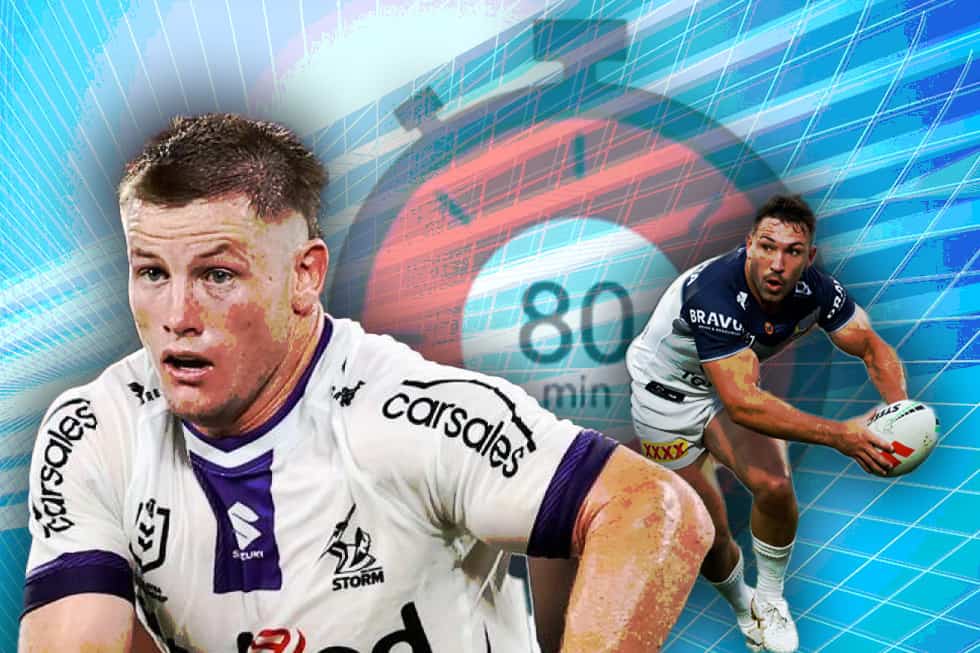Rugby league is faster and players are more powerful and explosive than ever before. Is playing 80 minutes at hooker too much to ask in the modern NRL?
For a large portion of rugby league fans, even just whispering the name Cameron Smith is enough to strike fear into their bones. Rugby league’s most relentlessly successful player was the model rugby league hooker; playing the full 80 minutes in complete control of a match’s tempo.
While he’s only been removed from professional rugby league recently, the modern game has fewer Cameron Smiths than ever before. And with that reality, there are fewer 80-minute hookers in the NRL than ever before.
Why is this the case? Is it tactical, or are there fewer workhorse options being developed? Or perhaps the physical requirements of modern rugby league are too demanding for this mould of dummy half.
Why are 80-minute hookers more uncommon than ever?
In 2023, five hookers would qualify as 80-minute players; guys who played the entirety of games more often than not. They are Canterbury’s Reed Mahoney, Reece Robson of the Cowboys, Jeremy Marshall-King at the Dolphins, South Sydney’s Damien Cook and Cronulla’s Blayke Brailey.
Rewind a decade and alongside Smith and Ennis there was Robbie Farah, Andrew McCullough, Mitch Rein, Jake Friend, James Segeyaro, Matt Ballin and Nathan Friend who were considered 80-minute guys at various stages.
Of course, rewind the clock even further and the concept of hookers playing anything other than a full game was ludicrous.
In 2024, this is not the case. In fact, we’re likely to see a further reduction in 80-minute hookers this coming season with Canterbury’s recruitment of Drew Hutchinson, Kurt Mann and Jake Turpin likely resulting in a reduction of Mahoney’s minutes, while 2023’s three other 80-minute operators each have bench utilities capable of providing them with a breather.
Now, it’s important to note the death of the 80-minute hooker has been slowly bubbling away for many years now. In the 2015 NRL Grand Final, the victorious North Queensland Cowboys utilised Jake Granville and Rory Kostjasyn at dummy half. In 2017, it was Granville and Ben Hampton, while the 2019 decider between the Roosters and Storm saw the Bondi outfit run with both Jake Friend and Sam Verrills.
Evidently, the decline of the 80-minute hooker has been a long time coming. However, in recent years the trend has experienced a rapid acceleration, facilitated by rugby league’s changing nature. Now more than ever, the game is quicker, the players more explosive, more agile and the physical demands placed on all players, and particularly those with the number nine on their back, are more extreme.
This can be largely traced to the introduction of 2020 rule changes where, in a bid to increase the game’s speed and consequentially rugby league’s appeal as a spectacle. The NRL infamously introduced the six-again rule, penalising defending sides for being offside or ruck infringements by awarding the attacking team a repeat set.
As a result, the game became incredibly quick. Not only did this make for a more appealing product, to a broader audience that appreciates attacking play, than the one served up during the mid-to-late 2010s, but it’s also set in motion drastic adjustments to how coaches use rotational players.
One of the major losers of this rule change was the rugby league wrestle, whose death was set in motion by ruck infringement punishments. With the phasing out of the wrestle, of which the like of Cameron Smith certainly excelled, so too we’ve seen the decline of the 80-minute hooker.

As a result of increased game speed, fatigue is much more prominent in rugby league, particularly in the middle forwards, but also hookers. Influenced by the lack of wrestle, middle forwards are getting through more work at quicker paces. Of the 10 top tacklers in the 2023 season, nine played in the middle: six hookers and three locks.
With this workload occurring at increased speeds, coaches are becoming smarter in their bench rotation, valuing maximised output of their hookers in fewer minutes, as opposed to wringing them dry for the full game and running the risk of fatigued-induced mistakes and less dynamic threat at the ruck.
Running with a bench utility capable of covering the forwards, as well as shoehorning at dummy half when necessary, is now increasingly popular. Kurt Mann, Drew Hutchinson, Sili Havili, Jake Granville, Cameron Mcinnes, Conor Watson, Erin Clark, Chris Randall, and Jazz Tevaga all exemplify this trend.
On top of this, it’s becoming increasingly common for sides to select specialist hookers on their bench like Jake Turpin, Danny Levi, Tom Starling, Tyson Smoothy, Soni Luke and Jake Simpkin, among others.
Even at rugby league’s pinnacle – State of Origin – both New South Wales and Queensland rotate dummy halves. For the Blues, it’s Damian Cook and Reece Robson, or Api Koroisau while the Maroons mix Ben Hunt and Harry Grant.
It’s not only that modern rugby league’s pace takes a lot more out of hookers, who make more tired tackles more often, it’s also the fact the rules, and gameplay, are conducive to effective running hookers darting from dummy half and exploiting tired legs throughout the middle of the field.
Players like Brandon Smith and Harry Grant, two of rugby league’s finest dummy halves, are also two of the game’s most effective, dangerous ball runners, particularly through gaps in tired middle defences. Even players on a tier below in the hooker ranking, like Jeremy Marshall-King, slice tired defences open with their electric running game.
Such a system is highly effective because not only is a running hooker a dangerous proposition for defenders, demanding enough eyeballs and attention to create even the faintest amount of extra time for the rest of their side, but they also relieve pressure upon their forwards through their ability to eat metres, slightly reducing their workload.
With momentum one of rugby league’s great deciding factors, having a running dummy half, or even one who’s not run-first but brings fresh legs off the bench, to exploit defensive lapses and propel a side forward; an extremely useful weapon for most coaches.
Certain coaches, like Parramatta’s Brad Arthur, are strict subscribers to the school of 80-minute hookers; understandable, giving part of his coaching education was undertaken at Melbourne.
Despite this, the consensus among top sides is that the dual-hooker system is most effective in modern rugby league. Penrith, for example, won the 2022 Premierships with a dual-hooker system; Mitch Kenny to bear the brunt of rugby league’s physical sting before Api Koroisau came on and worked his magic against tiring legs.
In 2023, the Panthers completed their three-peat with Kenny playing the full Grand Final against Brisbane and the prelim against Melbourne. Throughout the season, he’d only played 75 minutes or more five times, with Soni Luke, Tyrone Peachey or Jack Cogger acting as his deputy.
It’s not just Ivan Cleary who values the dual-hooker system. Since Cameron Smith’s retirement, Craig Bellamy’s implemented it also. Granted, this was initially done because Harry Grant and Brandon Smith are too good to not be utilised, and Smith can play as a middle forward, but even after the New Zealand international left Bellamy for Bondi, the master-coach often utilised Tyran Wishart or Bronson Garlick as Grant’s extra lung.
At the back end of 2023, Grant twice came off the bench. His first outing off the pine, against Canberra, highlights why so many coaches stray from utilising an 80-minute dummy half. In fewer minutes, and presumably less fatigue, Grant scored and assisted a try, made just 24 tackles and ran for his second-highest metres total (124) all season.
In fact, of 2023’s top eight sides, only Cronulla strictly adhered to the old-school single hooker system, though the presence of Mcinnes on the bench limits the risk of this approach, given he can cover at dummy half should an injury happen to Brailey.
Utilising two dummy halves is not only a tactic to minimise the impacts of fatigue and maximise the output of an essential element of a rugby league spine, as it also mitigates against the risk of injuries — which seem to have grown more prevalent in recent years, and head injury assessment’s (HIA).
Given the size difference between dummy halves and the monstrous middle forwards they’re tackling 40 times a game, collecting a stray hip or elbow and spending 15 minutes, or harsher consequences in more serious head blows, is sadly not an uncommon occurrence.
Moving in to 2024, it’s likely the Bulldogs won’t subject Reed Mahoney to play every minute of every match, especially with the plethora of worthwhile deputies they have for the former Parramatta man. In part, this will help preserve Mahoney and maximise his output, but could also improve their leaky middle defence. Don’t forget, clubs should be concerned with the longevity of their star players and not churn their shelf life.
That leaves only Blayke Brailey, Jeremy Marshall-King, Damien Cook and Reece Robson as the four remaining 80-minute hookers in the competition. So just like the Black Rhino in southern Africa, the 80-minute hooker is a critically endangered species.





